ARM Boards for DSP Applications
- 1. M. S. Ramaiah School of Advanced Studies 1 M. Sc. (Engg.) in Electronics System Design Engineering GREESHMA S CWB0913004 , FT-20136thModule Presentation Module code : ESE2511 Module name : Microcontrollers and Interfacing Module leader: Mr. Nagananda S.N. Presentation on : 07/05/2014 ARM Boards for DSP Applications
- 2. M. S. Ramaiah School of Advanced Studies 2 ŌĆóINTRODUCTION ŌĆóARM9E-S ŌĆóDM3730 ŌĆóFUNCTIONALBLOCKDIAGRAM ŌĆóBLOCKDIAGRAM ŌĆóSOFTWAREARCHITECTURE ŌĆóCHARACTERISTICSOFDSPPROCESSORS ŌĆóFEATURESOFDM3730 ŌĆóREPRESENTINGADIGITALSIGNAL ŌĆóADDITIONANDSUBTRACTIONOFFIXED-POINTSIGNAL Overview
- 3. M. S. Ramaiah School of Advanced Studies 3 ŌĆóMULTIPLICATIONANDDIVISIONOFFIXED-POINTSIGNAL ŌĆóSQUAREROOTOFFIXEDPOINTSIGNAL ŌĆóDSPONARM9E ŌĆóDSPONARM10E ŌĆóFIRFILTER ŌĆóIIRFILTER ŌĆóTHEDISCRETEANDFASTFOURIERTRANSFORM ŌĆóAPPLICATIONS ŌĆóCONCLUSION ŌĆóREFERENCES Overview
- 4. M. S. Ramaiah School of Advanced Studies 4Introduction ’é¦Emergingstandardsforalgorithmsinmanyapplicationareashaveputfurtherdemandsontheabilityofprocessingplatformstodeliverefficientcontrolcapability ’é¦ARMŌĆÖsapproachhasbeentodesignRISCcorearchitectureswithinstructionsetsthatprovideefficientsupportforparticularapplications,withoptimalbalancebetweenhardwareandsoftwareimplementation ’é¦Toacceleratesignal-processingalgorithmsARMaddsnewDSPinstructionstotheARMinstructionset ’é¦ARMDSPextensionsbroadenthesuitabilityoftheARMCPUfamilytoapplicationsthatrequireintensivesignalprocessingandatthesametimeretainingthepowerandefficiencyofahighperformanceRISCmicrocontroller ’é¦TheARMDSPextensionshavealreadybeenimplementedintheARM926EJ-S, ARM946E-S,ARM966E-S,ARM9E-S
- 5. M. S. Ramaiah School of Advanced Studies 5Introduction ’é¦Processing digitalized signals requires high memory bandwidths and fast multiplyaccumulate operations ’é¦A microcontroller handles the user interface, and a separate DSP processor manipulate digitalized signals such as audio ’é¦A single-core design can reduce cost and power consumption over a two-core solution ’é¦The ARMv5TE extensions available in the ARM9E and later cores provideefficient multiply accumulate operations ’é¦DSP applications are typically multiply and load-store intensive ’é¦Filtering is most commonly used signal processing operation ’é¦Another very common algorithm is the Discrete Fourier Transform
- 6. M. S. Ramaiah School of Advanced Studies 6 Introduction
- 7. M. S. Ramaiah School of Advanced Studies 7ARM9E-S ’é¦The ARM9E-S core has the ARM architecture v5TE ’é¦This includes an enhanced multiplier design for improved DSP performance ’é¦It is a 32-bit microcontroller ’é¦It offers high performance for very low power consumption and gate count ’é¦The ARM architecture is based on Reduced Instruction Set Computer (RISC) principles ’é¦The reduced instruction set and related decode mechanism are much simpler than those of Complex Instruction Set Computer (CISC) designs ’é¦This simplicity gives ŌĆóa high instruction throughput ŌĆóan excellent real-time interrupt response ŌĆóa small, cost effective, processor macrocell
- 8. M. S. Ramaiah School of Advanced Studies 8DM3730 ’é¦Based on enhanced device architecture ’é¦Integrated on TIŌĆÖs advanced 45-nm technology ’é¦Device supports HLOS and RTOS ’é¦Fully backward compatible
- 9. M. S. Ramaiah School of Advanced Studies 9Functional Block DiagramFigure 1 : DM3730 Functional Block Diagram
- 10. M. S. Ramaiah School of Advanced Studies 10 Block Diagram ’é¦Benefits ŌĆó2000DMIPS for Oss like linux, Win CE, RTOS ŌĆó3-D graphics up to 20M polygons per second for robust GUIs ŌĆóBackward compatible with OMAP3530 Figure 2 : DM3730 BlockDiagram ’é¦Application ŌĆóSmart connected devices ŌĆóPatient monitoring ŌĆóMedia Player
- 11. M. S. Ramaiah School of Advanced Studies 11Software ArchitectureFigure 3 : Software Architecture of DM3730 ’é¦Industry Standard OS component ’é¦TI provider component ’é¦Open Source
- 12. M. S. Ramaiah School of Advanced Studies 12 Characteristics of DSP processor ’é¦Harvard Architecture ’é¦High performance MAC ’é¦Saturating math ’é¦SIMD instruction for parallel computation ’é¦Barrel shifters ’é¦Floating point hardware
- 13. M. S. Ramaiah School of Advanced Studies 13Features of DM3730 ’é¦ARM microprocessor subsystem ’é¦Enhanced direct memory access controller ’é¦Video hardware accelerators ’é¦Tile based architecture delivering up to 20MPoly/sec ’é¦DSP instructions/data little Endian ’é¦NEON multimedia architecture ’é¦Load store architecture with Non-aligned support ’é¦64 32-Bit General purpose registers ’é¦Six ALUs, each supports single 32-bit, dual 16-bit, or quad-8 bit , Arithmetic per clock cycle
- 14. M. S. Ramaiah School of Advanced Studies 14Representing a Digital Signal Figure 4 : Digitalizing an Analogue Signal ’é¦xis signal and t is time ’é¦In an analogue signal x[t ], the index tand the value x are both continuous real variables ’é¦ARM uses fixed point representation
- 15. M. S. Ramaiah School of Advanced Studies 15 Addition and Subtraction of Fixed-Point Signals ’é¦The general case is to convert the signal equation ’é¦Fixed-point format ’é¦or in integer C ’é¦n = m = d. Therefore normal integer addition gives a fixed-point ’é¦Provided d = m or d = n
- 16. M. S. Ramaiah School of Advanced Studies 16ContdŌĆ” ’é¦There are four common ways you can prevent overflow ŌĆóEnsure that the X[t ]and C[t ] representations have one bit of spare headroom each ŌĆóUse a larger container type for Y than for X and C ŌĆóUse a smaller Q representation for y[t ] ŌĆóFor example, if d = n ŌłÆ 1 = m ŌłÆ 1, then the operation becomes ŌĆóUse saturation
- 17. M. S. Ramaiah School of Advanced Studies 17Multiplication of Fixed-Point Signals ’é¦The general case is to convert the signal equation ’é¦Fixed point format ’é¦or in integer CDivision of Fixed-Point Signals ’é¦The general case is to convert the signal equation ’é¦fixed point format ’é¦or in integer C
- 18. M. S. Ramaiah School of Advanced Studies 18Square Root of a Fixed-Point Signals ’é¦The general case is to convert the signal equation ’é¦Fixed point format ’é¦or in integer C
- 19. M. S. Ramaiah School of Advanced Studies 19DSP on the ARM9E ’é¦The ARM9E core has a very fast pipelined multiplier array that performs a 32-bit by 16-bit multiply in a single issue cycleWriting DSP Code for the ARM9E ’é¦The ARMv5TE architecture multiply operations are capable of unpacking 16-bit halvesfrom 32-bit words and multiplying them ’é¦The multiply operations do not early terminate. Therefore use MUL and MLA for multiplying 32-bit integers. For 16-bit values use SMULxy and SMLAxy ’é¦Multiply is the same speed as multiply accumulate. Use the SMLAxy instructionrather than a separate multiply and add
- 20. M. S. Ramaiah School of Advanced Studies 20DSP on the ARM10E ’é¦The ARM10E implements a background loading mechanism to accelerate load and storemultiples ’é¦It uses a 64-bit-wide data path that can transfer two registers on every background cycleWriting DSP Code for the ARM10E ’é¦Load and store multiples run in the background to give a high memory bandwidth ’é¦Ensure data arrays are 64-bit aligned so that load and store multiple operations canTransfer two words per cycle ’é¦The multiply operations do not early terminate. Therefore use MUL and MLA for multiplying 32-bit integers. For 16-bit values use SMULxy and SMLAxy ’é¦The SMLAxy instruction takes one cycle more than SMULxy
- 21. M. S. Ramaiah School of Advanced Studies 21FIR filters ’é¦The finite impulse response (FIR) filter is a basicbuilding block of many DSP applications ’é¦FIR filter to remove unwanted frequency ranges, boostcertain frequencies, or implement special effects ’é¦The FIR filter is the simplest type of digital filter ’é¦The filtered sample y(t)depends linearly on afixed, finite number of unfilteredsamples x(t) ’é¦Calculating accumulated values A[t ]
- 22. M. S. Ramaiah School of Advanced Studies 22IIR filters ’é¦An infinite impulse response (IIR) filter is a digital filter that depends linearly on a finite number of input samplesand a finite number of previous filter outputs ’é¦Mathematically ’é¦Factorize the filter into a series of bi quadsŌĆöanIIR filter with M = L = 2 ’é¦Z-Transform
- 23. M. S. Ramaiah School of Advanced Studies 23The Discrete Fourier TransformThe Fast Fourier Transform ’é¦The DiscreteFourier Transform (DFT)converts a time domain signal to a frequency domain signal ’é¦A FFT is an algorithm to compute the discrete Fourier transform and its inverse
- 24. M. S. Ramaiah School of Advanced Studies 24Applications ’é¦Portable data terminals ’é¦Navigation ’é¦Auto Infotainment ’é¦Gaming ’é¦Medical Imaging ’é¦Home automation ’é¦Single board
- 25. M. S. Ramaiah School of Advanced Studies 25Conclusion ’é¦DM3730 cost effective ’é¦It is low power and has high performance ’é¦DM3730 delivers a nearly 40% increase in ARM performance ’é¦Over 50% increase in DSP performance ’é¦Has twice the graphics capability, while reducing power consumption ’é¦Use a fixed-point representation for DSP applications where speed is critical withmoderate dynamic range
- 26. M. S. Ramaiah School of Advanced Studies 26Reference 1.DM3730, http:// www.ti.com/lit/ds/symlink/dm3730.pdf 2.DM3730, http://www.ti.com/lit/ml/sprt571/sprt571.pdf 3.DM3730, http://media.digikey.com/pdf/ DM3730_AM3703TorpedoSOMBrief.pdf
- 27. M. S. Ramaiah School of Advanced Studies 27
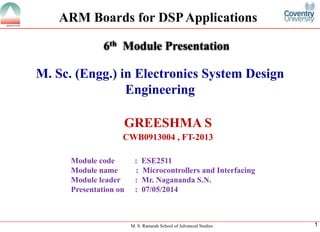
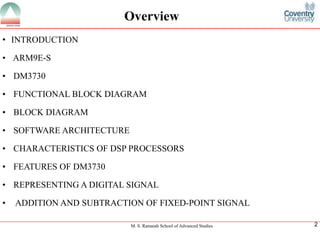




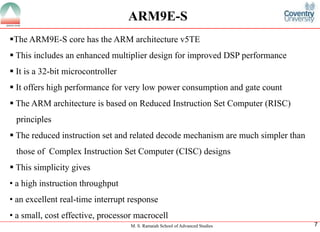
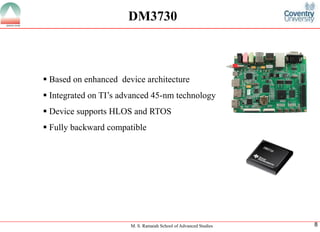




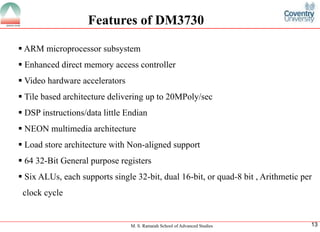
![M. S. Ramaiah School of Advanced Studies
14Representing a Digital Signal Figure 4 : Digitalizing an Analogue Signal
’é¦xis signal and t is time
’é¦In an analogue signal x[t ], the index tand the value x are both continuous real variables
’é¦ARM uses fixed point representation](https://image.slidesharecdn.com/greeshmascwb0913004ese2511-140912055152-phpapp01/85/ARM-Boards-for-DSP-Applications-14-320.jpg)

![M. S. Ramaiah School of Advanced Studies
16ContdŌĆ”
’é¦There are four common ways you can prevent overflow
ŌĆóEnsure that the X[t ]and C[t ] representations have one bit of spare headroom each
ŌĆóUse a larger container type for Y than for X and C
ŌĆóUse a smaller Q representation for y[t ]
ŌĆóFor example, if d = n ŌłÆ 1 = m ŌłÆ 1, then the operation becomes
ŌĆóUse saturation](https://image.slidesharecdn.com/greeshmascwb0913004ese2511-140912055152-phpapp01/85/ARM-Boards-for-DSP-Applications-16-320.jpg)




![M. S. Ramaiah School of Advanced Studies
21FIR filters
’é¦The finite impulse response (FIR) filter is a basicbuilding block of many DSP applications
’é¦FIR filter to remove unwanted frequency ranges, boostcertain frequencies, or implement special effects
’é¦The FIR filter is the simplest type of digital filter
’é¦The filtered sample y(t)depends linearly on afixed, finite number of unfilteredsamples x(t)
’é¦Calculating accumulated values A[t ]](https://image.slidesharecdn.com/greeshmascwb0913004ese2511-140912055152-phpapp01/85/ARM-Boards-for-DSP-Applications-21-320.jpg)





